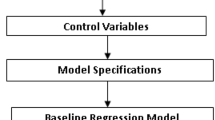Abstract
Effective corporate governance helps build vibrant and efficient capital markets. There was a remarkable transformation in the disclosure practices of Indian companies since the legislation of corporate governance norms through Clause 49 of the Listing Agreement in the year 2000. This in turn improved both the quantity and quality of information available for an investor in the capital market. Ideally, this should result in ‘informationally-efficient’ stock markets. This article investigates the consequences of governance regulations and the impact of information diffusion on Indian capital market efficiency using GARCH (1, 1). The corporate governance legislation through Clause 49 had a significant impact on the Indian stock market volatility. There has been substantial reduction in market volatility in the post-governance act period. However, there was no evidence substantiating that additional news improved the informational efficiency of the markets. In fact, the additional information resulted in greater volatility persistence.

Similar content being viewed by others
References
Alles, M.G. and Vasarhely, M.A. (2007) The need to reengineer the business reporting process. International Journal of Disclosure and Governance 4 (3): 204–216.
Bae, K.-H. and Goyal, V.K. (2010) Equity market liberalization and corporate governance. Journal of Corporate Finance 16 (5): 609–621.
Botosan, C. and Plumlee, M. (2002) A re-examination of disclosure level and expected cost of equity capital. Journal of Accounting Research 40 (1): 21–41.
Brown, S. and Hillegeist, S.A. (2007) How disclosure affects the level of information asymmetry. Review of Accounting Studies 12 (2–3): 443–477.
Cai, J., Quian, Y. and Liu, Y. (2009) Information asymmetry and corporate governance. Drexel College of Business Research Paper No. 2008-02. Available at SSRN: http://ssrn.com/abstract=1082589.
Chen, W.-P., Chung, H., Lee, C. and Liao, W.-L. (2007) Corporate governance and equity liquidity: Analysis of S&P transparency and disclosure rankings. Corporate Governance: An International Review 15 (4): 644–660.
Christine, X.J. and Jang-Chul, K. 2005 Trading costs of non-U.S. stocks on the New York stock exchange: The effect of institutional ownership, analyst following, and market regulation. Journal of Financial Research 28 (3): 439–459.
Contrera, M., Mara, J. and Yamamoto, M.M. (2006) Corporate governance: Information disclosure level and its relation with the stock price volatility on Ibovespa. Revista Contabilidade & Finanças – USP 17 (42): 65–79.
Eleswarapu, V., Thompson, R.R. and Venkataraman, K. (2004) The impact of regulation fair disclosure: Trading costs and information asymmetry. CFA Digest 34 (4): 9–10, 2p.
Ferreira, M.A. and Laux, P.A. (2005) Corporate governance, idiosyncratic risk, and information flow. AFA 2006 Boston Meetings Paper, http://papers.ssrn.com/sol3/papers.cfm?abstract_id=620822.
Grossman, S.J. and Stiglitz, J.E. (1980) On the impossibility of informationally efficient markets. American Economic Review 70 (3): 393–408.
Gilson, R.J. (2000) Transparency, corporate governance and capital markets, www.oecd.org/dataoecd/55/45/1921785.pdf, accessed April 2000.
Gompers, P., Ishii, J. and Metrick, A. (2003) Corporate governance and equity prices. Quarterly Journal of Economics 118 (1): 107–155.
Hetamsaria, N. and Sovan Deb, S. 2004 Impact of index futures on Indian stock market volatility: An application of GARCH model. Journal of Applied Finance 10 (10): 51–63.
Jain, P.K., Kim, J.-C. and Rezaee, Z. (2008) The Sarbanes–Oxley Act of 2002 and market liquidity. Financial Review 43 (3): 361–382.
Joshi, P. and Pandya, K. (2008) Exploring movements of stock price volatility. Journal of Applied Finance 14 (3): 5–32.
Kanagaretnam, K., Lobo, G.J. and Whalen, D.J. (2007) Does good governance reduce information asymmetry around quarterly earnings announcements? Journal of Accounting and Public Policy 26 (4): 497–522.
Kim, J.H. and Shamsuddin, A. (2008) Are Asian markets efficient? Evidence from new multiple variance tests. Journal of Empirical Finance 15 (3): 518–532.
La Porta, R., Lopez-De-Silanes, F. and Shleifer, A. (2006) What works in securities laws? The Journal of Finance 61 (1): 1–32.
Narayan Sah, A. and Omkarnath, G 2007 Are there trends towards market efficiency? A study of the Indian market. Journal of Applied Finance 13 (2): 71–86.
Nath, G.C. and Dalvi, M. (2005) A suitable volatility measure in Indian stock market. Journal of Applied Finance 11 (9): 16–22.
Nicolaou, A.I. (2009) Integrated information systems and transparency in business reporting. International Journal of Disclosure and Governance 7 (3): 216–226.
Roychowdhury, S. (2009) Discussion of ‘The numbers game in the pre- and post-Sarbanes–Oxley eras’ by E. Bartov and D. Cohen. Journal of Accounting, Auditing and Finance 24 (4): 535–541.
Sehgal, A. and Mulraj, J. 2007 Corporate governance in India: Moving gradually from a regulatory model to a market-driven model – A survey. International Journal of Disclosure and Governance 5 (3): 205–235.
Shen, C.H. and Lin, K.-L. (2010) The impact of corporate governance on the relationship between fundamental information analysis and stock returns. Emerging Markets Finance & Trade 46 (5): 90–105.
Thenmozhi, M. and Thomas, S.M. (2004) Impact of index derivatives on S&P CNX nifty volatility: Information efficiency and expiration effects. Journal of Applied Finance 10 (9): 36–55.
Welker, M. 1995 Disclosure policy, information asymmetry and liquidity in equity markets. Contemporary Accounting Research 11 (2): 801–827.
Zhang, I.X. (2007) Economic consequences of Sarbanes–Oxley Act of 2002. Journal of Accounting and Economics 44 (1/2): 74–115, 42.
Author information
Authors and Affiliations
Corresponding author
Additional information
1a doctorate in finance from the University of Madras, Dr (Mrs) P. Krishna Prasanna is presently assistant professor at Indian Institute of Technology (IIT), Chennai. Her doctoral research is on corporate governance and she has published several papers and articles on this subject. Dr Prasanna advises Solaron on relevant products for the market and provides guidance to the analyst team.
Rights and permissions
About this article
Cite this article
Prasanna, P. Impact of corporate governance regulations on Indian stock market volatility and efficiency. Int J Discl Gov 10, 1–12 (2013). https://doi.org/10.1057/jdg.2011.28
Received:
Revised:
Published:
Issue Date:
DOI: https://doi.org/10.1057/jdg.2011.28




